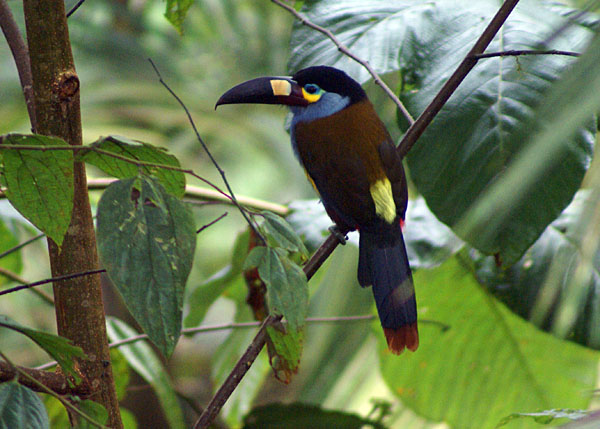
Andigena laminirostris
TAXONOMY
Andigena laminirostris Gould, 1850. This species shares the
genus Andigena with three other species of mountain toucans.
The group appears to be a “link” between the saffron toucanet
(Baillonius) and true toucans (Ramphastos).
OTHER COMMON NAMES
French: Toucan montagnard; German: Leistenschnabel-tukan;
Spanish: Tucбn Andino Piquilaminado.
PHYSICAL CHARACTERISTICS
Length about 20 in (51 cm). Weight 11.1 oz (316 g) male; 10.7
oz (305 g) female. A dark olive-brown bird with slate-blue underparts;
the dark bill has a raised, rectangular, cream-colored
plate near the base; skin surrounding the eye is blue above and
yellow below.
DISTRIBUTION
Comparatively small range, restricted to a band on the west
slope of the Andes from southwestern Colombia through western
Ecuador. Thought to undergo seasonal altitudinal migration
in Colombia.
HABITAT
This species occupies humid montane rainforest where
bromeliads and mosses are abundant. Although usually found
at 3,900–10,500 ft (1,200–3,200 m), seasonal altitudinal migration
occurs and birds may be found as low as 990 ft (300 m).
BEHAVIOR
Call (equivalent of song) is nasal, whining sound that rises with
each note. Often seen foraging in pairs or small groups, and
sometimes accompanies mixed-species flocks. Larger flocks of a
dozen or more birds form in the fall, after nestlings fledge; at
this time birds in Colombia may migrate downslope in search
of food.
FEEDING ECOLOGY AND DIET
Adult birds forage in small groups of three to six, usually up in
the forest canopy; daily movements of small flocks vary depending
on location of ripe fruit. At least 49 plant species produce
fruits eaten by this toucan; most are in the Cecropia family
and most are swallowed whole. Remsen et al. examined stomach
contents of eight specimens and found only fruit; no
arthropods or small vertebrates; however nestlings are fed beetles
as well as birds’ eggs, snails, and mice along with fruit.
REPRODUCTIVE BIOLOGY
Breeding season peaks in June and July, when the weather is
driest and fruit is most abundant. When a pair of toucans is
ready to begin nesting, they drive away the other members of
the small group with which they usually forage. Nesting pairs
also sometimes evict toucan-barbets from active nests to get
control of a tree cavity. The cavities selected are often in
trees in the familiy Laureaceae; birds are thought to do some
excavation to modify the cavity and entrance hole. Courtshipfeeding
occurs before copulation. Both male and female incubate
the eggs and feed the young. The nestlings fledge 46–60
days after hatching but the parents continue to feed them for
two or three weeks; a second clutch sometimes follows.
CONSERVATION STATUS
Near Threatened due to habit loss from intensive logging, human
settlement, cattle grazing, mining, and palm cultivation.
Large tracts of suitable habitat do remain, however with some
areas already protected. The species may be threatened to a
lesser extent by the international cage bird trade.
SIGNIFICANCE TO HUMANS
A desired sighting for bird watchers.
Photo Gallery of - Plate-billed mountain toucan




 Animalia Life
Animalia Life